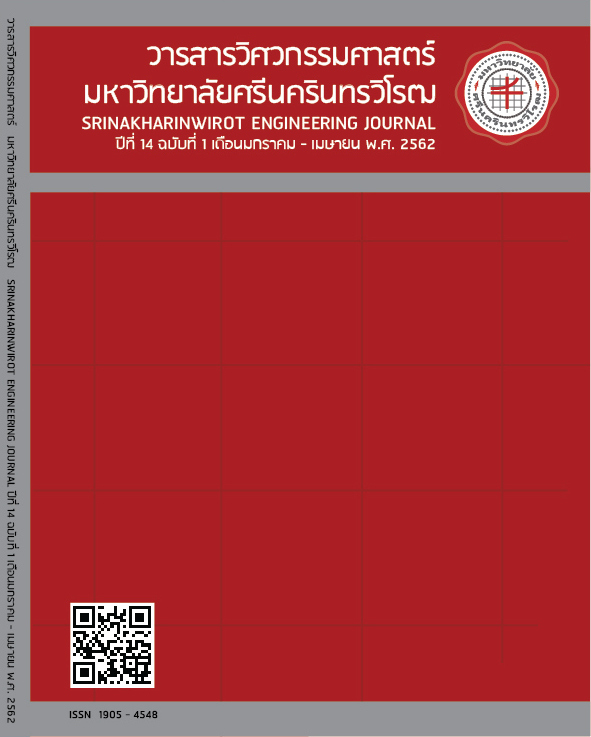A study of the efficiency of a solar water heater
Main Article Content
Abstract
The average intensity of solar radiation in Thailand is 18.2 MJ/m2 -day. This amount of energy should be utilized to reduce the energy consumption from the other sources such as the fossil energy. The main objective of this research is to study the efficiency of a DIY solar water heater. The solar water heater has two main components: a flat plate collector and a storage tank. Thermosiphon principle is used for water circulation between the collector and the storage tank. The collector has 1x1 m2 area and consist of 9 copper tubes with a diameter of 5/8 in. and a black aluminum plate. The storage tank has 50 liter volume. The thermocouples type K were used to measure the inlet and outlet temperature of water from the collector, and the water in the storage tank. Pyranometer was used to measure the intensity of solar radiation. The machine had been tested between 9:00-16:00 for 5 days in April. The results showed that the mean intensity of solar radiation was about 690 W/m2 and its maximum was 993 W/m2 at 11:45 on the fifth day. The maximum water temperature in the storage tank was 50 oC at 13:00. The five days average of the maximum efficiency of each day was 55.8% and the five days average of the all day average efficiency was 24.6%
Article Details
Copyright belongs to Srinakharinwirot University Engineering Journal
References
[2] กรมพัฒนาและส่งเสริมพลังงาน และภาควิชาฟสิกส์ คณะวิทยาศาสตร์ มหาวิทยาลัยศิลปากร. “แผนที่ศักยภาพพลังงานแสงอาทิตย์”, กันยายน 2542
[3] วีระพล แต้สมบัติ, เจษฎา แก้วกัลยา, สุภาวดี แคลลา, อุทุมพร นิตยาคม, กิตติศักดิ์ โชติมุณี และภัสรา รอดอ่อน. “โครงการศึกษาการบริหารจัดการทรัพยากรน้ำของชาติอย่างมีประสิทธิภาพ และการจัดการ 25 ลุ่มน้ำสําคัญของประเทศ”, รายงานการศึกษาฉบับสุดท้าย. สํานักนโยบายสาธารณะ สํานักงานสภาที่ปรึกษาเศรษฐกิจและสังคมแห่งชาติ. 59 หน้า. 2547.
[4] มารุต บูรพา, ณัฐนี วรยศ, ทนงเกียรติ เกียรติศิริโรจน์ และ สุริยนต์ ชมดี. “โมเดลอย่างง่ายของการทำน้ำร้อนแสงอาทิตย์ที่ใช้ความร้อนเสริม”, วารสารคณะเทคโนโลยีอุตสาหกรรมมหาวิทยาลัยราชภัฏลำปาง, ฉบับที่ 1, เล่มที่ 2, หน้า 15 – 23, 2551.
[5] รุ่งทวี ผดากาล และ สุรชัย รดาการ. “การศึกษาปัจจัยที่มีผลต่อประสิทธิภาพของระบบผลิตน้ำร้อน”. วิศวกรรมสาร มก., ฉบับที่ 70, หน้า 96-109,พฤศจิกายน 2552 - มกราคม 2553.
[6] จักรพันธ์ พิรักษา และ ซังเซ็ง เลียงจินดาถาวร., “การศึกษาสมรรถนะของเครื่องทำน้ำร้อนพลังงานแสงอาทิตย์ชนิดแผ่นราบแบบหมุนเวียนน้ำตามธรรมชาติ” วารสารวิชาการ ม.อบ., ฉบับที่ 2, หน้า 9-18, พฤษภาคม-สิงหาคม 2549.
[7] นาถพงศ์ เสนีย์รัตนประยูร, จันทกานต์ ทวีกุล, ชูเกียรติ คุปตานนท์, และ ปัญญรักษ์ งามศรีตระกูล. “การศึกษาประสิทธิภาพแผงรับพลังงานแสงอาทิตย์ในการผลิตน้ำร้อน โดยใช้โปรแกรม EnergyPlus” การประชุมวิชาการเครือข่ายวิศวกรรมเครื่องกลแห่งประเทศไทยครั้งที่ 21., จังหวัดชลบุรี 17-19 ตุลาคม 2550., หน้า 1282-1287.
[8] ศศิษา เรี่ยมสุวรรณ. “การเปรียบเทียบระบบทำน้ำร้อนแบบใช้ปั๊มความร้อนกับใช้แผงรับรังสีพลังงานแสงอาทิตย์แบบแผ่นเรียบสำหรับอาคารพักอาศัยการเปรียบเทียบ ระบบทำน้ำร้อนแบบใช้ปั๊มความร้อนกับใช้แผงรับรังสีพลังงานแสงอาทิตย์แบบแผ่นเรียบสำหรับอาคารพักอาศัย” วิทยานิพนธ์ (วท.ม) เทคโนโลยีและการจัดการพลังงาน (สหสาขาวิชา). จุฬาลงกรณ์มหาวิทยาลัย, 2554.
[9] กองพัฒนาพลังงานทดแทน ฝ่ายแผนงานพัฒนาโรงไฟฟ้า การไฟฟ้าฝ่ายผลิตแห่งประเทศไทย. (2560). เครื่องทำน้ำร้อนพลังงานแสงอาทิตย์ [Online]. Available: https://www4.egat.co.th/re/egat_business/egat_heater/egat_heater.htm
[10] L. Pastel and C. Waterguy. (2018, June 28). Thermosiphon [Online]. Available: https://www.appropedia.org/Thermosiphon
[11] A. Zerrouki, A. Boumedien, and K. Bouhadef “The natural circulation solar water heater model with linear temperature distribution.” Renew. Energ. vol. 26, no. 4, pp.549-559, 2002.


